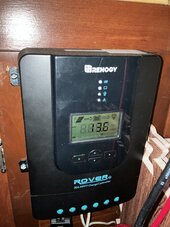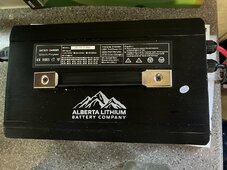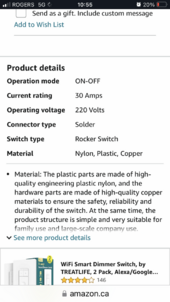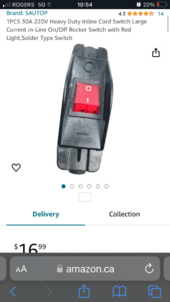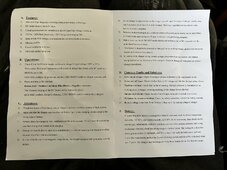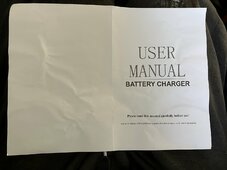You are using an out of date browser. It may not display this or other websites correctly.
You should upgrade or use an alternative browser.
You should upgrade or use an alternative browser.
Lifepo4 voltage drop recently
- Thread starter Echo Dawn
- Start date
RV8R
Solar Enthusiast
On the DC side of things do you see the switch isolating my solar aray just below the controller?
Yes;
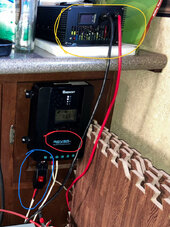
Blue circle; What is the make / model ?
Red circle; Rover MPPT Make / Model?
Yellow circle; AC to DC Charger ? Make / Model ?
So I can spend time searching the internet & the “Rover” is an easy one to “Sleuth” or You can help by listing the make & model of your electrical equipment.
I can clearly see the Inverter
You should have manuals on all this equipment ,,, or produce performance specifications in the very least.
RV8R
Solar Enthusiast
I’m heading off the forum momentarily, but will leave you with some things to consider in regards to your system;
Fuses
Switches
Buses
Positive connections safety covers
Product identification ( Make / Model ) get manuals & product performance specs (PV)
Possibly an electrical schematic
Load Chart or “Energy Audit”
I know you are dealing with learning LFP / BMS / Charging right now, so will leave you with those ideas for your future consideration.
Good Luck with it All !!
Fuses
Switches
Buses
Positive connections safety covers
Product identification ( Make / Model ) get manuals & product performance specs (PV)
Possibly an electrical schematic
Load Chart or “Energy Audit”
I know you are dealing with learning LFP / BMS / Charging right now, so will leave you with those ideas for your future consideration.
Good Luck with it All !!
RV8R
Solar Enthusiast
Thank you RV8R
I very much appreciate your helpful feedback
You are very welcome !!
30 amp MPPT charger
60 amp “Alberta Lithium” charger
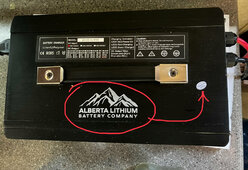
IMO, caring about charging batteries is pretty important to the health of the batteries. For me, I want to unsure my chargers & settings are matched to the battery manufacturer’s charging specifications.
& I can’t do that if I don’t have the battery manual ( in general ) ,,, thus far I am not impressed with “Alberta Lithium” ,,, they seem short on details ,,, nice snowmobile photo though

RV8R
Solar Enthusiast
And if you notice in any of the photos I’ve seen of people enjoying their machines and toys there’s no pictures of their batteries or products in their use…
Ya;
They need to “up their game”. I notice the single paper manual doesn’t even have their company name on it.
Without much involvement, I am just going to assume big on internet sales & low on customer support.
I try to buy chargers that are “User Programmable” ( also multi battery chemistry ). You might want to consider that for any future charger.
Victron 100 | 50 MPPT - User Programable
Kisae 1250 DC2DC & Solar - User Programable “ & Kisae “Surrey BC” the bestbtech support I have ever experienced
MisterSandals
Participation Medalist
Battery voltage measurement is only meaningful for a battery at rest. You posted pics of your 60A charger showing 14.4V while charging and your Rover SCC showing 13.5V while charging.Do you think if I hit the reset button last night when it reached 14.4 V that I would’ve woke up to a different state of charge this morning according to my BMS?
Other words I would’ve been at 92%, and the right voltage?
If charged quickly up to a certain voltage and not allowed to absorb, this is mostly just a surface charge. Imaging splashing water on a sponge to where it feels very wet while the inside may be very dry. Given enough time to settle, the surface charge will be absorbed more evenly throughout and a measurement on the surface will be more representative of the overall saturation. (sorry for mixing terms metaphorically.
Similarly, when your charger reads 14.4V and you think the battery is fully charged to that level, applying even a modest load will quickly burn off this surface charge and the voltage will drop drastically.
If you were to hold the battery at 14.4V until the charge current drops to well under an amp, then your battery would become fully charged. This has been mentioned several times in different ways but i have not seen that you have achieved this.
Similar threads
- Replies
- 7
- Views
- 309
- Replies
- 6
- Views
- 536
- Replies
- 7
- Views
- 353
- Replies
- 4
- Views
- 461
- Replies
- 11
- Views
- 1K



